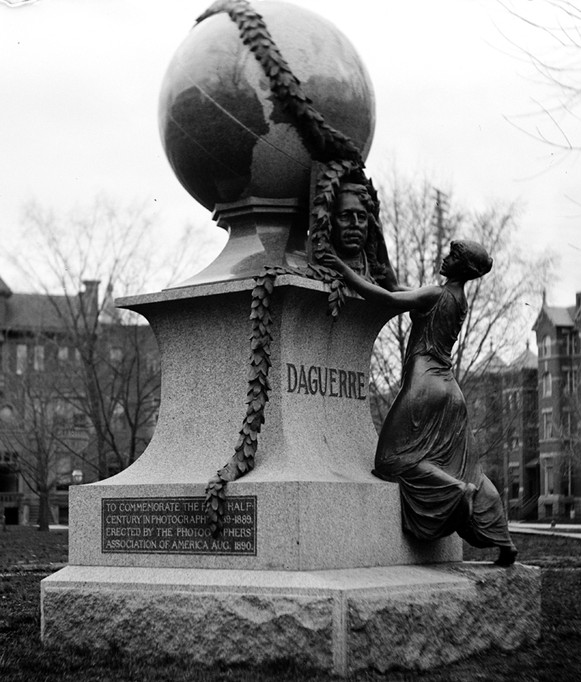Location of the Daguerre Memorial (1890 to 1969)
Introduction
Text-to-speech Audio
From its dedication in 1890 to its removal from the National Mall in 1969, this was the site of a monument commissioned by the Photographers' Association of America honoring French artist and inventor Louis-Jacques-Mandé Daguerre (1787-1851). In 1839, Daugerre invented the first practical process to capture images. The resulting still image was called a "daguerreotype," and the technique spread quickly around the world. Daguerre's innovation used chemical reactions to capture a detailed and enduring image on a copper plate in just a few minutes. The process required a subject to be still, and in the 1840s and much of the 1850s, this technology was used to create portraits, including thousands that have been preserved. The monument was removed in the late 1960s, a period when the monumental landscape of the National Mall centered more on American political leaders and monuments to veterans. Recognizing the value of Daguerre's contribution to the world, the memorial was taken out of storage and placed at the National Portrait Gallery in 1989. The monument features a bust of Daguerre between a globe and a female figure representing Fame. The assertions of one of the monument's inscriptions demonstrate the ethos of the era when it was created. One inscription reads, "Photograph, the electric telegraph, and the steam engine are the three greatest discoveries of the age. No five centuries in human progress can show such strides as these."
Images
This monument was located here from 1890 to 1969. Its removal demonstrates the way the National Mall changed over the last century.

Backstory and Context
Text-to-speech Audio
One of Washington D.C.'s lesser-known monuments, the Daguerre Memorial can now be found at the National Portrait Gallery. The monument has become a popular place for capturing "selfies" among those who know the history behind the French inventor's revolutionary technology, which removed barriers. A daguerreotype could be obtained at a fraction of the cost of commissioning a painting. During the 1850s, the process of capturing photographs on glass and paper replaced the daguerreotype. Still, the influence of Daguerre was so great that this monument to a French citizen was placed on the National Mall outside the Arts and Industries Building and remained there for nearly eight decades.
Louis Daguerre was born on November 18, 1787, in northern France. His artistic talents were apparent at a young age, and when he was 16, he became an apprentice under panorama painter Pierre Prévost. At the time, large, curved panoramas were painted for theaters as backdrops. Daguerre eventually painted panoramas for plays and operas, and from 1821 to 1822, he built a "diorama" theater next to his studio. It was round and could fit 350 people. It was also designed to rotate to show spectators the entire painting, which was either transparent or opaque.
Daguerre's interest in photography began when he started using the camera obscura technique to help his painting work, and refined the method by creating better lenses. Then in 1826, Daguerre learned about the work of Joseph Niépce (1765-1833), who invented the first photographic process called heliography in 1825. The two men became partners in 1829 and eventually developed a photography process in 1832 called physautotype that could capture images in less than eight hours. Unfortunately, Niépce died of a stroke in 1833 but Daguerre continued the work. Daguerre's breakthrough came when he discovered that mercury vapor accelerated the creation of an image down to 30 minutes.
In 1838 he began to tell a few trusted artists and scientists about his invention. One of these was astronomer and legislator François Arago, who secured a lifetime pension from the French government for Daguerre in exchange for the rights to the daguerreotype process (Niépce's son agreed to the exchange and also received a lifetime pension).
Daguerre formally presented the process to the world on August 19, 1839, at a joint session of the French Academy of Sciences and the French Academy of the Arts. His invention was revolutionary, and because it was relatively affordable, it quickly spread around the world. The process was immediately utilized by artists, scientists, archaeologists, and explorers. Although he was required to provide a detailed booklet detailing the step-by-step demonstration of the process, Daguerre kept the patent on the equipment used to make daguerreotype photographs. Daguerreotype became less prevalent as photographs on glass and paper, which were faster and cheaper to produce, emerged in the 1850s. Paper prints, in particular, while not as detailed as daguerreotypes, were able to be reproduced easily.
Daguerre died in 1851 at the age of 63 in a suburb of Paris. Unfortunately, few of his daguerreotypes still exist after a fire destroyed his laboratory and diorama in 1839. In addition, Daguerre's written records and early experimental works were lost.
Sources
"Biography of Louis Daguerre, Inventor of Daguerreotype Photography." Thought Co. Updated January 30, 2020. Accessed November 8, 2022. https://www.thoughtco.com/louis-daguerre-daguerreotype-1991565.
Daniel, Malcolm. "The Daguerreian Age in France: 1839–55." The Metropolitan Museum of Art. October 2004. https://www.metmuseum.org/toah/hd/fdag/hd_fdag.htm#thumbnails.
Daniel, Malcolm. "Daguerre (1787–1851) and the Invention of Photography." October 2004. https://www.metmuseum.org/toah/hd/dagu/hd_dagu.htm.
Whitmire, Vi. "Louis-Jacques-Mandé Daguerre." International Photography Hall of Fame and Museum. Accessed November 8, 2022. https://iphf.org/inductees/louis-jacques-mande-daguerre.
